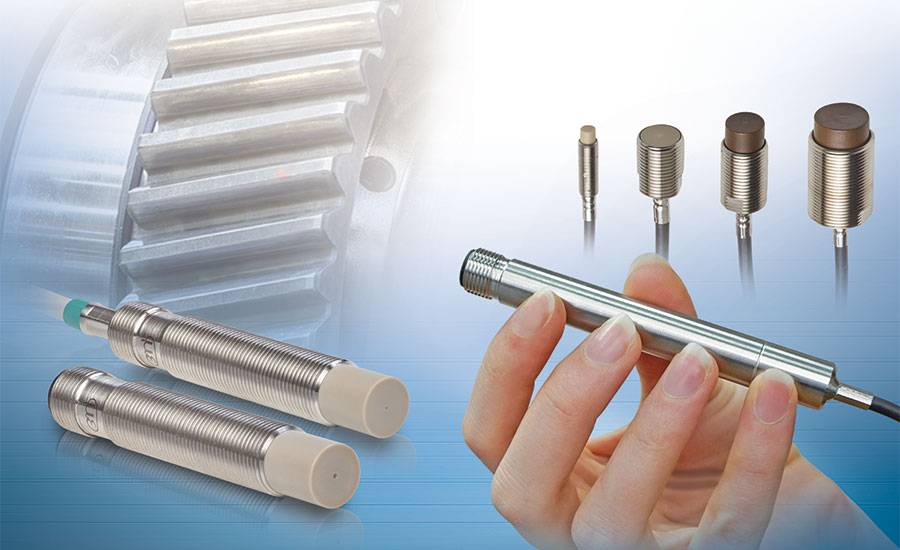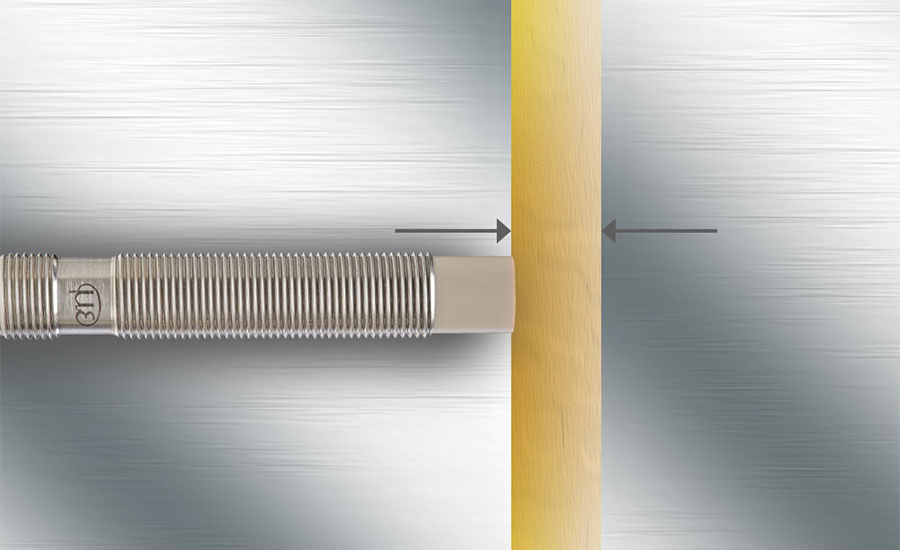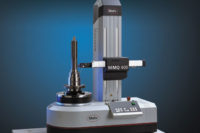Eddy current displacement sensors combine several advantages. They provide high precision and resolution on a wear-free, noncontact basis. They are resistant to external influences such as dirt, pressure and fluctuating temperatures and therefore are ideally suited to harsh industrial environments.
The eddy current principle occupies a unique position amongst inductive measuring methods. Measuring via eddy current is based on the extraction of energy from an oscillating circuit. This energy is needed for the induction of eddy currents in electrically-conductive materials. Here, a coil is supplied with alternating current whereby a magnetic field forms around the coil. If an electrically conducting object is placed in this magnetic field, eddy currents are induced which form a field according to Faraday’s induction law. This field acts against the field of the coil, which also causes a change in the impedance of the coil. This impedance can be calculated by the controller by looking at the change in the amplitude and phase position of the sensor coil.
The principle can be used for measurements of all electrically conductive materials. The special coil wrapping of the sensors enables very compact sensor designs, which can still be used across high temperature ranges. As eddy current penetrates insulator materials, even metal behind an insulating layer can be used as a measuring object.
For this reason, dust, dirt and oil do not affect the measurement. This enables highly precise measurements in harsh industrial environments.
Oil gap in hydrostatic bearings
Eddy current displacement sensors can be used in large plant and machinery such as stone mills or telescopic installations which often work with hydrostatic bearings. These bearing systems are continuously supplied with liquid lubricant via an external pressure supply. The lubricant is pressed between the bearing surfaces, which are therefore continuously separated from one another by a thin lubricant film. The bearing surfaces are not exposed to any friction and hence operate wear-free. This enables sub-micrometer position control. Any disturbances in the hydraulics (e.g. pressure drops) can have disastrous consequences, resulting in damage to the bearings and ultimately system failure, causing high maintenance and repair costs. The oil gap in hydrostatic bearings must therefore always be inspected reliably, which is possible with an eddy current sensor.
Eddy current displacement sensors are suitable particularly where pressure, dirt, oil and high temperatures are present. New eddy current measurement systems for fast, high precision displacement measurements provide ease of use and high measurement accuracy. The sensor is ideally suited to OEM integration and mechanical engineering applications. Eddy current sensors and controller are temperature-compensated, which is why high measurement accuracies can be achieved even in fluctuating temperatures.

Eddy current sensors provide a “clean performance” in dirty conditions
Unconditional precision
Eddy current sensors offer extremely precise measurements and are used where micron accuracies are required. In order to ensure high measurement accuracy even with fluctuating temperatures, the sensors are actively temperature-compensated. Ambient temperature fluctuations are one of the critical factors that influence the accuracy of measurement results. In terms of temperature fluctuations, there are basically two factors that influence the measurement signal. These are mechanical changes, where the geometric dimensions of the sensor and the target change in the form of extension or contraction. Alternatively, there are electrical influences that have a greater impact than mechanical changes. In this case, the electromagnetic characteristics also change. Active temperature compensation can be used in order to improve temperature stability. In complex processes, the effects of temperature fluctuations are accounted for. Being used in ambient temperatures from -40 C to more than +200 C, eddy current displacement sensors are robust against temperature fluctuations. The design and active temperature compensation provide these sensors with an extremely high temperature stability.
However, the technical specifications from different manufacturers often do not show if their systems are temperature compensated. They only provide indications of temperature ranges for operation and/or storage. It is therefore important to consider temperature compensation and, if necessary, to ask the sensor supplier for details, as temperature is a key factor for successful measurements.

Inspection of the oil gap in hydrostatic bearings using eddy current sensors.
Adaptable and individual
The customers are as different as the industries where the sensors are used and the conditions under which the measurements are carried out. Eddy current displacement sensors offer the possibility to deal with customer requests and to create individual solutions. Modifications to the standard eddy current sensors are often required, particularly for mid-size and large series. The measurement systems can be adapted in many different ways to suit customer-specific applications, e.g. changes to the cable, sensor material and design, and to the controller (bandwidth, output signal, filter, etc.). For example, sensors with integrated electronics in a miniature housing or special sensor designs are often requested by system integrators. Examples of customized modifications are modified offset and measuring range, housing and mounting options for sensor, pressure-resistant sensors up to 2,000 bar, miniaturized sensors, various materials for coil, housing and circuit boards, individual cable lengths, specific target calibrations. The technology behind eddy current sensors has continuously improved and successfully adapted to new requirements.


